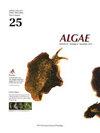丙酸钙对Pyropia养殖加工过程中卵菌病原体的控制
IF 2.4
3区 生物学
Q1 MARINE & FRESHWATER BIOLOGY
引用次数: 1
摘要
卵菌病原体腐霉(Pythium porphyrae)引起红腐病,而Olpidiopsis spp.引起Olpidipsos枯萎病,给韩国Pyropia海水养殖场造成了严重的经济损失。在Pyropia加工的洗涤步骤中,这些病原体迅速繁殖,显著降低了最终产品的质量。为了开发针对这些病原体的非酸性治疗方法,测试了各种钙盐对卟啉单胞菌和焦斑单胞菌配子体的感染力,丙酸钙是最有效的。当Pyropia叶片在接种卵菌病原体后浸入10mM丙酸钙中1小时时,两种卵菌病原体在第2天的感染率(7.1%)显著低于对照(>95%)。Pyropia刀片在丙酸钙中的短暂孵育也减少了感染的传播。在用100mM丙酸钙处理30s后,Pyropia铊的感染面积在2天内减少到对照的14.3%。在实际水产养殖场进行的田间实验中,已经表明,每两周用100mM的丙酸钙短暂清洗30s可以有效地减少卵菌在整个培养期的传播。上述结果表明,丙酸钙不仅可以在海藻加工过程中,而且可以在水产养殖过程中控制卵菌的传播。本文章由计算机程序翻译,如有差异,请以英文原文为准。
Control of oomycete pathogens during Pyropia farming and processing using calcium propionate
The oomycete pathogens Pythium porphyrae, causing red rot disease, and Olpidiopsis spp. causing Olpidiopsis-blight, cause serious economic losses to Pyropia sea farms in Korea. During the washing step for Pyropia processing, these pathogens proliferate rapidly, significantly reducing the quality of the final product. To develop non-acidic treatments for these pathogens, various calcium salts were tested against the infectivity of P. porphyrae and Olpidiopsis pyropiae on Pyropia gametophytes, and calcium propionate was the most effective. When Pyropia blades were immersed in 10 mM calcium propionate for 1 h after inoculation with the oomycete pathogen, infection rate of both oomycete pathogens on day 2 was significantly lower (7.1%) than control (>95%). Brief incubation of Pyropia blades in calcium propionate also reduced the spread of infection. The infected area of Pyropia thallus was reduced to 14.3% of the control in 2 days after treatment with 100 mM calcium propionate for 30 s. In field experiments conducted in actual aquaculture farms, it has been shown that a brief 30 s wash every two weeks with 100 mM calcium propionate can effectively reduce the spread of oomycetes throughout the entire culture period. The above results suggest that calcium propionate can be a useful means for controlling the spread of oomycetes not only during laver processing but also during aquaculture.
求助全文
通过发布文献求助,成功后即可免费获取论文全文。
去求助
来源期刊

Algae
PLANT SCIENCES-
CiteScore
5.10
自引率
25.00%
发文量
18
期刊介绍:
ALGAE is published by the Korean Society of Phycology and provides prompt publication of original works on phycology. ALGAE publishes articles on all aspects of phylogenetics and taxonomy, ecology and population biology, physiology and biochemistry, cell and molecular biology, and biotechnology and applied phycology. Checklists or equivalent manu-scripts may be considered for publication only if they contribute original information on taxonomy (e.g., new combinations), ecology or biogeography of more than just local relevance. Contributions may take the form of Original Research Articles, Research Notes, Review Articles and Book Reviews.
 求助内容:
求助内容: 应助结果提醒方式:
应助结果提醒方式:


